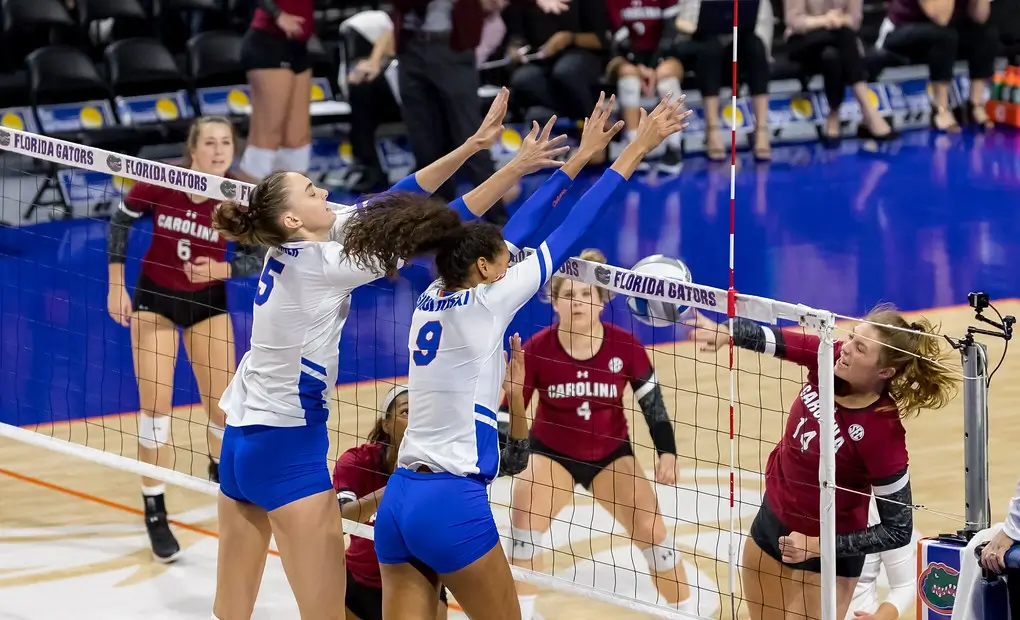Last Updated: January 12, 2024
Blocking is a strategy in volleyball that, if not used appropriately, can turn the outcome of the play. In a volleyball competition, blocking can demoralize your opponents and boost or lower your team’s esteem.
To be safer, explore some advanced blocking techniques, which are explained in detail in this article.
To everyone, making a block is all about returning the ball to your opponent’s side. But a good block should catch your opponent off guard. You should be a strategic thinker, disciplined and capable of making precise moves to become a great blocker. Above all, remember you are not playing alone, teamwork will help you build a better defense and lay the ground for winning.
Types of Blocks

Understanding the different types of volleyball blocks helps you up your defense gameplay. As a team, knowing when to use each blocking technique will support you in building a strong defense that can lead to success.
One-on-One Block
This is where one blocker takes a direct battle with the opposing hitter. The main aim is to prevent the hitter from scoring by blocking their attack. Otherwise, a blocker can use this method to set a double-block to confuse the opponents more.
Two-on-One Block
For this, two blockers should work together and cover a specific target area to deny an attacker from the other side access to the ball. This can also give your team more flexibility in defense after analyzing the opponent’s attack patterns.
Double-Block Technique
At least two or more players line up before the net to form a protective wall against the opponent’s attack. Practice timely positioning and keep constant communication and teamwork to achieve the double-block technique. Developing a solid wall on the front forces the hitter to play around it or over it, thus giving your defenders an easier time.
Blocking Strategies to Surprise Your Opponents
Never let your opponents know the move you will take next. Here are some methods you can use.
Soft Block
Though this might not be considered a block, it’s still a strategy you can use to get the ball back to the other side of the net. For example, if you are too short or cannot hit the ball over the net, try to keep it in play. To do this, reach high as if you want to block and quickly deflect the ball upwards. This move allows your teammates to play; they have only two contacts to pass the ball over though.
Solo Blocking
In solo blocking, you are the only one blocking the ball with no aid from your teammates. Position yourself in the hitter’s angle or line, then jump and perform the block as you intend. Alternatively, start a blocking position by assuming you have a blocking teammate. Next, jump and align your body to the line or angle to block.
Split Block
Making split blocks is a powerful strategy your team can embrace to surprise your opposing team players. Before a game, you discuss with fellow blockers who will make the block. For example, the right or outside blocker can take the angle hit while the middle blocker takes the line or vice versa. However, the back defenders can quickly defend through the space between the two blockers.
Advanced Blocking Techniques for Dominating in Volleyball
While there are many techniques, these are the main ones to help you become an expert.
1. Efficient Positioning and Timing
Your arms, eyes and feet should coordinate to make a better jump.
Arms
To get an excellent blocking stance, raise your arms above your shoulders, bend the elbows and let the palms face the setter. This can work to your advantage, making it hard for the attacker to target the ball over or around the arms. Additionally, please don’t put a wider gap between the arms to prevent the attackers from spiking between them. A narrower gap is better since it allows you to adjust quickly in case of an unanticipated attack.
Footwork
Use a footwork pattern that works for you: three-step crossover or two-step lateral. Whatever footwork you choose, ensure you are stable and face the net before jumping.
Eye work
Visual acuity is significant on the court. By seeing the physical movements of your opponent’s body, you can easily guess the outcome of their hit.
2. Analyzing the Setter’s Intentions
Study the setter’s intentions early enough. Next, determine the set your opponents are running and the direction your setter tends to look at more. For instance, if a left-handed setter sends the ball to an outside hitter, you should know the possible target area.
3. Examining Your Opponent’s Attack
This is practically the most critical part that will determine what move you can take. Look for visible clues from the attacker by observing their body language and movements to anticipate the possible target areas. Is your opponent standing near the net, or is he far away? Is the opponent tall or short? You can also check on their footwork or recall their past performance.
4. Staying Alert
If you want to master the craft of blocking, you must always be alert and focused. This will help you to stay in check and ready for any attack, even when faced with distractions. Physical and mental preparedness should go hand in hand for you to be alert on the court. Return to your actual position when you have finished blocking for better gameplay to other teammates.
5. Communicate Effectively with Teammates
Since you aren’t playing alone, you must always be aware of the exact positions of your teammates on the court. Effective communication allows you to anticipate your opponent’s steps and how to counter them. You can easily make errors in blocking without effective communication, forming grounds for losing.
6. Perform Regular Blocking Drills
Any team that wants to succeed should perform as many group training and individual defensive blocking drills as possible. Some primary areas to focus on when training are stretching and muscle-strengthening exercises. Moreover, train in exercises that can improve your mental alertness.
7. Examine Your Opponent’s Weak Points
During the first minutes of gameplay, you should identify your opponent’s weak points, strengths and how they handle different shots. This will be important as you now have a soft ground to hit on. It’s also nice to identify your weak points and work on them accordingly to prevent the attackers from constantly hitting you.
Steps to Make an Effective Block
1. Be in a Defensive Position
Be in a ready-to-defend posture as you wait for your opponents to develop their play. Face the net and be just an arm’s length from it. The distance between your feet should be slightly wider than your shoulder width. Bent the knees and arms slightly forward then be ready to act.
2. Watch How the Play Develops
Don’t wait until your opponent hits the ball to act; you will be too late. Instead, watch how the ball passes and the position the setter takes after getting the ball. Gather more clues since many setters aren’t as consistent in making hits. This way, you can quickly narrow down the possible options.
3. Moving to Intercept
After determining a setter’s next move, whether a quickset, topspin or tip, you should be ready to move and block the coming spike. Note that you aim to block the ball and not the hitter.
4. Time your Jump
Beginner players have a natural tendency to jump the instant as the hitter. No, it doesn’t work this way since the ball will arrive later when you’ve already finished your jump, and it will pass you. To rectify this, once the hitter makes the jump, give yourself a split second, then jump. But there can be an exception in case of a quickset where the hitter quickly makes contact with the ball just above the tape.
5. Use your Hands Appropriately
You don’t just lift your hands to block; they should be strong enough to undertake the blocking mission ahead. This is because the ball comes to you from the hitter with much power and velocity. Ensure the gap between your hands isn’t large enough for the ball to pass through. Furthermore, angle your hands correctly so that when you hit the ball, it goes over the net but inside the opponent’s court and does not bounce back.
6. Control the Seam
A seam in volleyball is a space not blocked by your hands. Your defense players trust that if the ball gets to your hands, you will block it, so they focus on the seam. Controlling the seam means not leaving a space wide enough between your hands for a ball from the hitter to pass.
Conclusion
In volleyball, a win or a loss is what it is and isn’t measured by what team blocked the best or had a better defense. But, you can easily sway down your opposing team’s morale by making a solid block that, in turn, gives you a win. Learning and implementing different blocking dynamics will also boost your team’s defense.
Blocking is considered a team’s primary mode of defense and the most entertaining action in volleyball. A good block stops your opponent from scoring by preventing a successful attack. Unluckily, it’s the least practiced by many teams. But for teams that know what blocking brings, they give it equal attention as other volleyball skills like serving, setting or digging in their drills.
